Response From the Field
A bunch of errors this time …
Angus points out that the name should be William "Bill"
Selden.
My apology, Bill.
Dave and Alta were kind enough to point-out that I had
two #15 issues. Oops. That’s why this number is #17—hopefully we are
now back on track.
Thanks for the help.
Ba-Boo: A Lady of Merit
…the matriarch that
starts it all…
By Pawel Andreev
Late August marks the end of summer, last chance
vacations, getting ready for school and the winding down of many
outdoor activities. However, one day in August has a very special
meaning. It is a day that denotes a closing chapter in my life; the
passing of my mom’s mother, Saha Ivanchukov.
As our maternal grandmother, we referred to her as Ba-Boo
(a cultural reference denoting respect and lineage). Born in 1893,
Ba-Boo lived during —the worst of times".
She witnessed two global depressions, two World Wars, the Korean
Conflict and the deadly Spanish Flu Pandemic, which by itself claimed
fifty million souls across the planet. Meanwhile poverty, pestilence
and strife wreaked untold tragedies upon the survivors. During such
carnage, Ba-Boo lost her spouse and more than half of her
offspring; but 5 made it to adulthood. My mother was the eldest
surviving child.
To begin this story, we go back over half a century. I
was a preschooler when Ba-Boo passed away. Besides vague images, I
recall an overall feeling of warmth and love that always emanated from
her; especially on the day she died. It’s a day I’ll never forget.
This all took place at my Grandmother’s house in Ulna
Gazur. The date was August 22nd, 1958 and Ba-boo
wasn’t feeling well. Something had made her dizzy and nauseous. I
remember she was in the bathroom sitting on a small, home-made wooden
step-stool. Anxiously attending her was my aunt Chaw-Cha Geencha.
Walking past the bathroom several times, I tried
checking in on my grandmother to see what was wrong, but my aunt kept
shooing me away. After all, how much help could a 4 ½ year old offer?
At least I managed to get a smile from Ba-Boo during one of my passing
patrols. Eventually, my aunt made me go outside to play. Shortly
afterwards, I was startled to see her running out of the house sobbing.
She was heading towards the temple in great haste!
There was someone following her, but they were lagging
far behind. It may have been my older aunt Chaw-Cha Kishta (who
was 7 months pregnant with Cousin Annie) or it may have been my
mom (who was 8 months pregnant with Brother Barry). In fact
it might have been both of them: I simply don’t remember. I was
probably still in shock from seeing my younger aunt crying so
uncontrollably. But I do remember how fast Chaw-Cha Geencha
was running. I knew she would be the first one to reach the temple. It
wasn’t long before an ambulance showed up to take my grandmother away.
Between the ensuing commotion and the panic of indecision, nobody paid
attention to me. Not knowing what to do, I obeyed my aunt and stayed
out of the way. With all the adults running around, I was scared.
Whatever happened, it was bad; because everyone was crying. What’s
worse – no one seemed to be in control. Looking back, the only word
that could describe that day was sheer pandemonium!
It was quite a few hours later, when somebody drove up
the driveway in a brand-new green convertible. Apparently, it was the
doctor. In all likelihood, it was the first time I saw a car with no
roof, let alone one so shiny and new (is that why I remember the
color?). Now the doctor’s arrival only made things worse, because
people started yelling at the man for showing up so late. Not
surprisingly, the tardy doctor bid a hasty retreat. I decided to urge
the doctor along by throwing rocks at his new car. It was just my way
of helping out. I should point out that no one told me to do that; but
then again, no one told me to stop.
Perhaps because it was my first funeral, many details
are sharply recalled. My Mom had prepared all of our dress clothing,
because she wanted us to look our best. On that day, there were lots of
big fluffy clouds, but the sun still shined through. Since it was quite
windy, it took several tries to light the cone-shaped incense my mom
had brought. I kept wondering: “Do we have enough matches?”
Eventually, my older siblings Ulanki and Roschin
managed to get them lit. Then mom carefully instructed us in the proper
prayer movements of steepled hands and bowed heads. We each took our
turn performing the ritual three times. There were many adults who
prayed after us. Quite a few of them I did not recognize, but most of
the kids I knew...
Now I’m an adult and my visits to the cemetery include
many more grave sites; most notably the resting places of my own
mother, father, aunt, uncle, older sister and brother. Yes, my
grandmother’s gravesite no longer seems so far back. After my mom’s
recent passing, I finally understand at the deepest level what my own
mom must have been going through back in August of ’58. What’s more, I
can fully relate to my aunt Chaw-Cha Geencha’s desperate
sobbing run over fifty years ago...
I miss my Ba-Boo; even though I hardly knew
her. My one regret is not having the chance to really know her better;
but at least I met her! For that I’m truly thankful, because there are
those who have never seen her. Deep inside, her presence lives on
through my few cherished memories of her. By sharing what scant
recollections I have, perhaps a little part of our grandmother will
live on. She had a very hard life, but it never prevented her from
seeking something better. She is the matriarch who came to the new
world almost 60 years ago. Without her; we wouldn’t even be
here!
Pawel Andreev
|
|
Steppe Notes 17-2010
The St. Zonkava Board
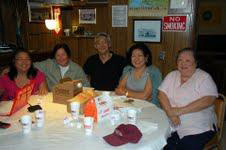
From
L to R: Natalie Abuschinow, Purma Muschajew, Gogol & Larisa
Kalatschinow, Vera Ulzinow 9/18/10 photo: nolefer
Purma, the President of the Brotherhood of St. Zonkava,
the organization that operates the Philadelphia temple, has wanted me
to visit with her board for some time. The opportunity for that
occurred on September 18th.We had a very good visit and some of the
communication problems that manifested during the summer may have been
resolved. I did not stay for the complete meeting, but after
discussion, of the New Jersey Folk Festival and its needs and the
celebration of the 60th Anniversary, the board members allowed me to
leave.
Nomin (Prayer) Class
As usual, I arrived for Nomin class early, so that there
was time to decompress from the road, and see if this day’s light would
give a new interpretation to images. Today, the spire on the temple
looks tempting. Soon afterwards a small black car appeared—a couple
with two kids in back of the car. These were new folk, Methodists who
began studying and practicing Buddhism. We talk; I try to put them at
ease.
Geshe Tenzin is walking towards us from his house. As he
draws nearer he looks at me and says, “You came all the way from New
York?” “Yes, Geshe,” I respond, as I bow in the manner of my tradition.
Geshe shakes his head and returns the bow. Then he turns to the couple.
The husband asks where he should park, Geshe makes a suggestion. The
family gets back in the car to go to the suggested spot.
Geshe and I begin to walk to the front of the temple.
“How are you doing, Geshe?” I ask. “I’m getting older,” Geshe responds.
“Geshe, that is a good thing,” I say with a laugh. Geshe gives a short
laugh. He stops and says, “I like your truck; that’s very useful.”
“Yes,” I respond, “That’s why I got it, to do things. It helped me
build a stone fence in front of our house. I collected rocks each day
at work and after a year, or so, I had enough rocks to build a fence;
very useful. I wish I could make an offering of it to you, but then how
would I get back home?” Geshe smiles and begins to unlock the temple.
“Is the door open?” he asks pointing to the house by the temple. “I
don’t know, I’ll go and check,” I respond.

Geshe
Tenzin instructs the kids
how to hold hands in prayer
position. Image reminiscent of
Nesterov’s painting. Photo:
nolefer, 2010
I went to the house—checked the door; it was locked.
Returned to temple. The family was coming up to it; the kids were
standing in front of the door. “Go in,” I said, “Just wipe your feet;
the monk is a very nice person.” The kids went in the parents followed,
worrying about shoes. I told them that in this temple people keep their
shoes on. Geshe was in the middle of the temple when we came in; I told
him that the house was locked so he went out to unlock it. The parents
and I talked and I tried to share what I knew about this temple. Geshe
returned and started teaching the kids how to hold their hands for
prayer and how to do prostrations. Then he started a series of prayers
with the kids by his side. At the end of the prayers he dabbed both
children with the water at the end of the peacock feather and said to
the parents: “He should be all right now; the prayers will help. You
may want to have prayers said in your house to banish the spirit that
is upsetting the child. You know children are much more sensitive than
we are.”
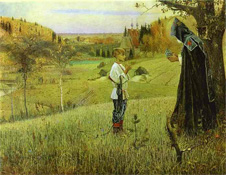
Geshe
Tenzin instructs the kids how to hold hands in prayer position. Image
reminiscent of Nesterov’s painting. Photo: nolefer, 2010

Tenzin
manyah teaching the kids how to do prostrations properly. Photo: nolefer
By this point other children and parents arrived and
Maria and Sharon, also. Both ladies made sure that everyone had their
shoes off and handed out the "Taking Refuge" prayer in Tibetan. First,
Geshe taught the kids how to do prostrations properly and only after
they did about nine of them to his satisfaction, he began his Dharma
talk.
 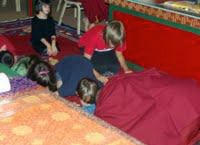
Geshe
teaching children how to do prostrations, while adults sit back and
look Photo: nolefer, 2010
Since two of the parents who came were Methodists, with
the mother studying to be a minister, Geshe became very ecumenical and
told the kids that "taking refuge" was simply asking the Buddha or
Christ to help them; and, that if they ask the Buddha or Christ to
help, he will always answer those prayers.
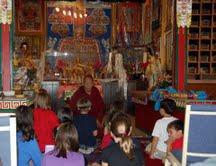
Children
listening to Geshe giving Dharma
talk Photo: nolefer, 2010
The ladies wanted Geshe to explain "Taking Refuge,"
which the Geshe did, but mostly as asking for help which will be given.
As Geshe was informed that the nun, who came from Rashi Gempil also had
a talk to give he concluded with a statement, after the prayer
recitation, that if the kids just prayed to the “Buddha, Dhrma, Sangha;
everything would be OK.” And his final injunction was: “The Buddha gave
this to me, and I give that to you.” One could feel the ire of the
educators rising; they wanted the kids to memorize the prayer, and
hoped that Geshe would use his authority to reinforce that position.
Then it was the turn of the nun from Rashi Gempil to
give a talk. She gave a Jataka tale (aka Buddha’s Birth Stories). This
probably did not work as envisioned, since Geshe Tensing would give his
commentary every few sentences as the nun tried to recount the tale. By
this time one of the mothers became upset that I was taking pictures,
so I ceased doing that, but as luck would have it some wonderful
juxtapositions of kids and monastics presented themselves immediately
after I stopped. My mind was distracted by that so I had little inkling
about the tale and only remember that it was a one that recommends
kindness to animals. The talk ended, more prostrations and the kids ran
off to get snacks.
St. Mary’s Vladimir's Russian Orthodox Cemetery
Previously I’ve been told that the Russian cemetery that
contains Kalmyk graves is at ROVA Farm, and that it is only a few miles
away from Tashi Lunpho. I decided to fill the time until Art’s class by
making a quick visit and photographing a few headstones.
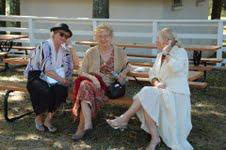
Three
Russian beauties at ROVA Farm
Photo: nolefer, 2010
The GPS did not list the cemetery or ROVA Farm as a
Point of Interest (POI) so I decided to drive to the center of Jackson
in the hopes of seeing a sign to either destination. Good idea; but it
didn’t work. No signage. I stopped at a pizza joint primarily to
"powder my nose," but also to grab a slice and ask for directions. The
bathroom was nice but pizza reminded me why one never orders a pizza in
New Jersey, or crab cakes in a diner. The owner, however, was friendly
with a great sense of décor. The focal point of the decoration was a
huge poster of Frank Sinatra, a copy of his mug-shot when he was
arrested by the Jackson gendarmes for the crime of "seduction." The
directions that he owner gave me got me to ROVA farm without mishap.
There was no cemetery there, however, the three Russian "maidens"
(their first query to me was: “Aren’t you going to take a picture of
three beauties?”) whose picture I immediately took, gave me directions.
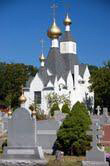 Unfortunately I followed the directions too literally
and wound-up going down some dirt road away from Jackson. The GPS saved
the day and I went down Cassville Road and found the cemetery.
I entered the cemetary grounds with a strange sense of
exitement. In some ways it felt as if I arrived home; among my own
people. On the other hand, I also felt the estrangment of someone who
has gone away from the group and intellectually fully comprehended that
there was little in commmon between me and the folks here. I kept
walking looking for Kalmyk names. I didn’t know if the Kalmyks were
buried together as a group, in one section of the cemetery, or if they
were scattered among the other graves.
The cemetery was much larger than I imagined; the sun
was bright, and as I continued to read the names something happened …
Suddenly I was at a summer weekend dance at ROVA Farm. Dark hall with a
small dance floor, surrounded by tables; bottles of whiskey or vodka;
plates of herring with scallions; men dressed in heavy woolen suits;
women in dresses with white gloves; and, enough cigarette smoke for a
three-alarm fire. The singer in skin-tight golden dress (which changes
hues as the light on the rotating plastic color wheel passes from green
to red, to blue, to yellow) stands by the microphone and is inundaded
with requests—“Nu, spoj ciganskuju” (“So, sing a gypsy song”). And her
husky soprano begins … “Moj koster v tumane svetit …” (“My fire burns
in the fog …”). And, of course, there is the dance music—foxtrots,
polkas, waltzes, and tangos.

Lienz
Memorial Chapel Photo: nolefer
But, then suddenly, I am among the Cossack graves. A
small memorial chapel commemorates the repatriation of Cossacks from
Lienz, Austria; my birthplace. Surrounding it are Russian, Ukrainian,
German, and "Tartar" names. Here lies "Mohamet," over there a chevalier
of three crosses of St. George—obviously a WWI veteran. Suddenly I feel
sad and think of great-uncle Basil. But, no Kalmyk names and I rembered
about Art’s class. I saw a lady talking to some fellow with a SLR
camera, and I figured that she must be working for the cemetery. My
surmize was correct, and she directed me to the section of the cemetery
reserved for Kalmyks.
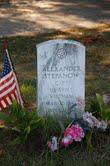
US
Army Capt. Alexander
Stepanow Photo: nolefer
And suddenly I find myself among non-Russian names and
with headstones many of which have the Dharma wheel instead of the
eight-pointed cross. One government-issue headstone for Captain
Stepanow, who survived Vietnam to die in 1990. Many headstones have the
names in Russian and English transcription. Many list their place of
origin in a particular stanica (Cossack term for village) and not a
Kalmyk aimak (Kalmyk equivalent for village). Some writing is either
Todo-bichig or Sanskrit, unfortunately I cannot tell the difference
without further study.
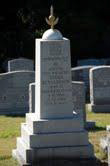
Don
Kalmyk Baksha Sodbo
Buruldinow Photo: nolefer
There are a number of lama gravesites. I make a mental
note that the lamas are buried with their compatriots and not with the
other Cossacks around the Lienz memorial. There is a story in that.
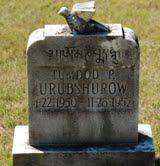
Grave
marker for Tumdod Urubshurow Photo: nolefer, 2010
One name--Boldyrew takes me back to the DP camp; I
wonder if these Boldyrews are related to the NTS Boldyrews? Another
story?
One of the oldest Kalmyk grave markers is also of one
of the youngest members of the community—Tumdod Urubshurow, barely two
years old.
Yes, this is definitely a place to visit with someone
who knows the community well and who can recount the stories connected
to the lives of folks who found their resting place here.
Suddenly, I realize that the time is past Art’s class.
One, final, walk around and I head home.
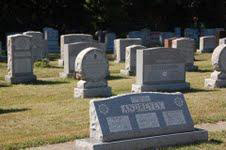
Small
section of the Kalmyk part of St. Vladimir’s cemetery Photo: nolefer,
2010
|





